Kaliko Journal is a free newsletter about natural dyeing, textiles, art practice, and life by Ania Grzeszek. This publication is divided into two sections: ”Plant Dyeing” and “Studio Practice”. You can manage your subscription by clicking “Unsubscribe” at the bottom of the email and opting IN and OUT of the sections that interest you. This is also where you can pledge your financial support for this publication, which would help me continue to sustain it.
Feel free to share parts of this letter wherever and with whomever you’d like, remembering to tag me. If you want to support my work, subscribe to this publication and/or purchase my handmade products. Take care of yourself wherever you are.
Coming back from my weekly group therapy session my brain is a mush but I want to take the afternoon to share this short (?) note with you regardless. Sometimes I pinch myself about having built a list of so many people who read my words and my biggest wish is that we actually come to a point of active exchange. I want to hear from you, having met some of you already and knowing how lovely and insightful you are. I’m eager to read your words, too.
This month I had a great pleasure of taking part in a plant-dyers’ meeting as a part of a local Fibershed community. We talked about things important to us as business owners, teachers, textile industry in-(or out)-siders, agriculture workers, activists and believers in change. Plant dyeing has so many facets to it and I wish we had more time to share experiences and brainstorm ideas (luckily we meet again soon! Thank you so much for organizing it, dear Anne and Elke!).
One thing that stood out to me is how many of us dyers are struggling with the communication aspect of our craft—making our clients realize what plant dyes can and can’t do. I wrote a few articles in the past about why I got into plant dyeing, how I don’t believe in plant dyes being able to replace synthetic dyes and why I decided to use synthetic dyes for my bag production. (Said articles got lost for a while when I was moving my website but I will soon publish them on my blog again.)
Today I want to share with you what plant dyes are to me and ask you to share your own thoughts, expectations, wishes and ideas. Let’s make it into a dreaming session and an active exchange between us.
Here are some of the things plant dyeing is for me:
Plant dyeing as an art practice
Plant dyeing has a wonderful quality of letting me jump between mediums. I can weave and knit with my plant dyed yarns, I learned to sew to only to be able to patch my dyed fabrics together, and only after discovering how to make pigments I got back to painting which I loved so much in the past. It feels so empowering to learn new things, and with plant dyeing learning never stops. It’s a vast outlet for creativity and personal growth and a practice that seems not to have an end. I see my output more as art pieces and less as textile products and I guess here lies the biggest perception shift. I don’t make textiles, I make art.
Plant dyeing as a lesson in sustainability
For me, as a person who believes in local, slow, considered, and respectful systems, plants dyeing is a great vehicle of communicating that. I try to live by my values, the main of all is doing no harm. Conventional textile industry harms both the environments we live in, as well as people who are being exploited and/or exposed to toxic substances. I like to think that by making my pieces by hand and sharing the process I help to build awareness around the consequences of conventional approaches. And it extends far beyond textiles, conscious consumers make conscious decisions in all parts of their lives. Maybe, just maybe, I can help plant this seed and make people reconsider their choices and thing further than “I like how it looks”.
Plant dyeing as a tool for connection
Hey, apart of being my job, plant dyeing is my hobby. And like most hobbies, a big part of it is community. What I love about teaching workshops is bringing people together to spend a few hours in each others presence, crafting, talking. Showing others how to work with their own hands, how to release expectations, and maybe even find a life lesson or two in the process. Plant practices bring us closer together and bring us closer to the world around us. Colors grow on trees! Just slow down and notice that and you’ll develop a much deeper appreciation for Mama Earth. How generous and how magical to be receiving such gifts. How lovely to share them with each other.
Things plant dyeing is not:
Not a cure to our industry
It’s not realistic to expect that plant dyes would ever be able to replace synthetic dyes. Our capitalist society consumes too much at this point. As mentioned, more in this article, but long story short: it takes huge resources (and areas) to grow natural color. Complying with color longevity standards and the need to produce repeatable color batches also make it almost impossible to proceed with industrial scale production. What the textile industry needs instead is transparency, standards for using (and disposing of) toxic substances, and respect for textile workers. Global Organic Textile Standard does just that. (A note here: I believe we should all buy less, second-hand if possible)
Not for everyone
And argument I hear sometimes: plant dyed products are too expensive and not accessible to some. On one hand, yes these are the rules of capitalism, on the other, do you even need one anyways? (if you want one but can’t afford it, you can learn to dye with plants and make it yourself like I did) What I’m actually getting at here is that plant dyed products are luxury products because plant color is art. Madder root red tshirt is not just any red tshirt. It’s a color grown and skillfully extracted by experts in this field. It’s conveying the message “I care about the environment”. It’s an art piece that you can wear as an armor. It’s expensive to make so it’s expensive to buy.
Not just a color
For me plant color should be free of usual expectations for a conventional color: to last many washes, to be resistant to stains, not to fade. Plant color is not equal non-toxic conventional color. Plant colors DO fade and DO change when splattered with lemon juice. But isn’t that part of their magic? They mature like no other color, develop beautiful patina, they change with seasons. What synthetic color can do that? In our Fibershed meeting someone compared plant color to wine and I loved it so much, imagine wearing Chamomile Yellow 2021, wow. And again, plant colors literally grow on trees, get picked, extracted and applied to fibers by real human hands! Magic.
I would love to hear what plant dyes are for you and what are your personal expectations? I would be grateful if you took the time to share your thoughts with me (with us!). Comments are open and email replies are welcome ♥️
Thank you for reading and see you again in 2 weeks,
Ania
For those of you who got to the very end, I want to show you new pieces I made. These patchworks are made with canvas scraps I dyed with plants (dyed, painted, eco-printed) and with synthetically dyed (GOTS) offcuts from my project bag production. I paired them together to compliment each other and slowly change at a different pace, but so that the color theme stays intact. My goal for this year is to use what I already have, intuitive patching is my favorite way to do that. There are 4 pieces left, each one completely unique and a small work of art for you to carry. Available here.
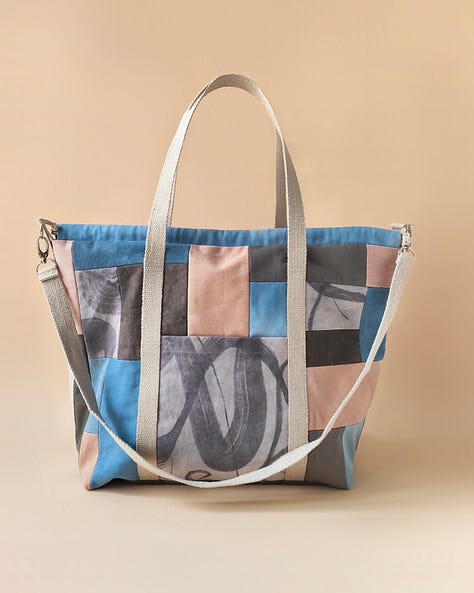
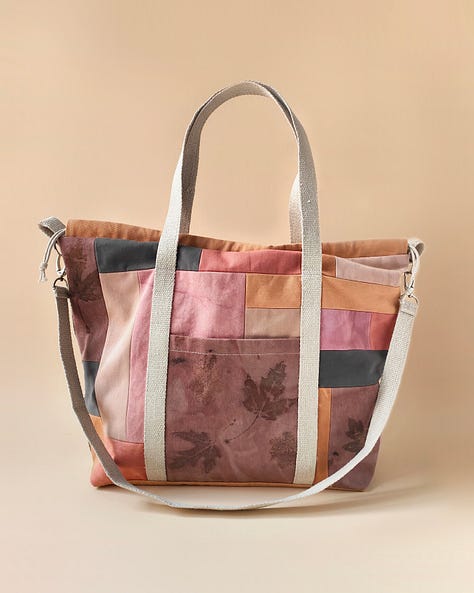
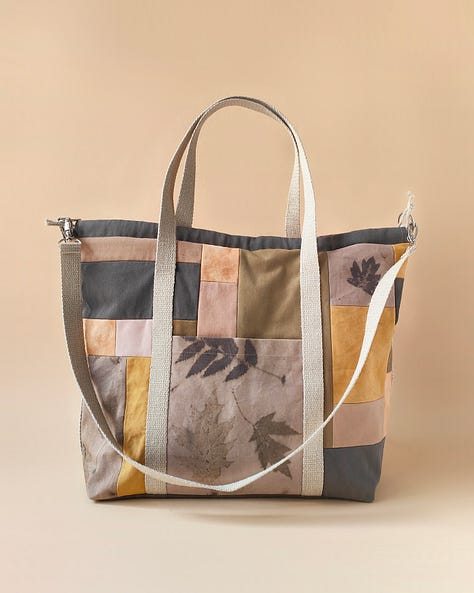
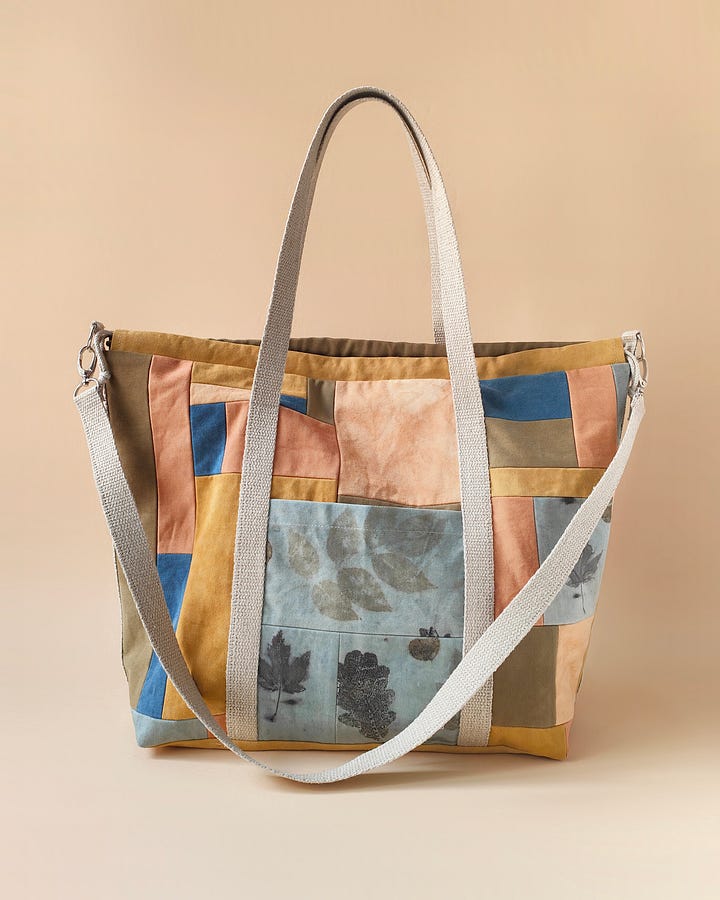
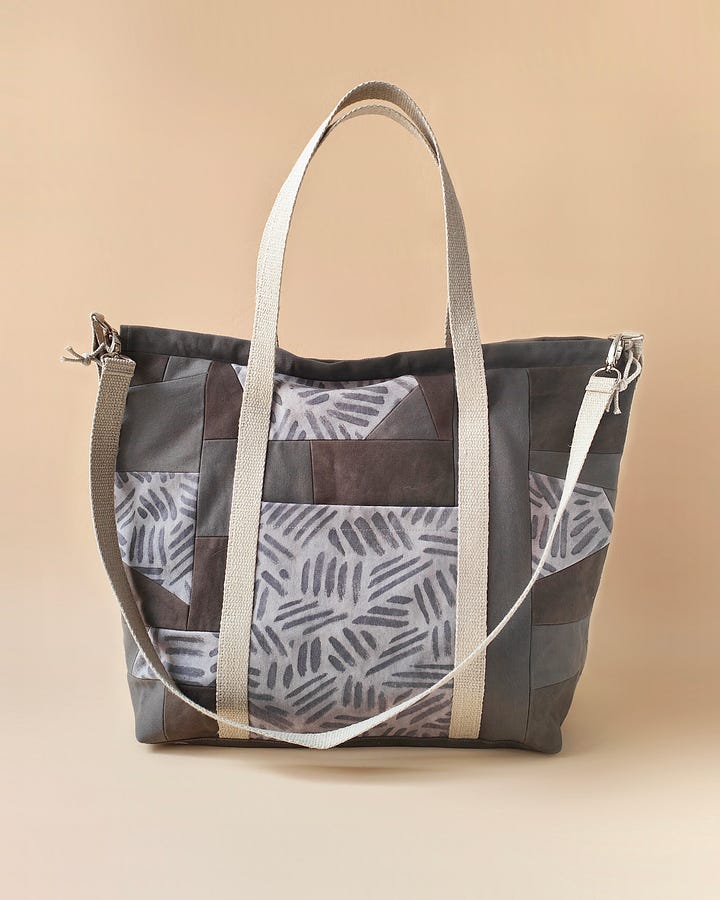


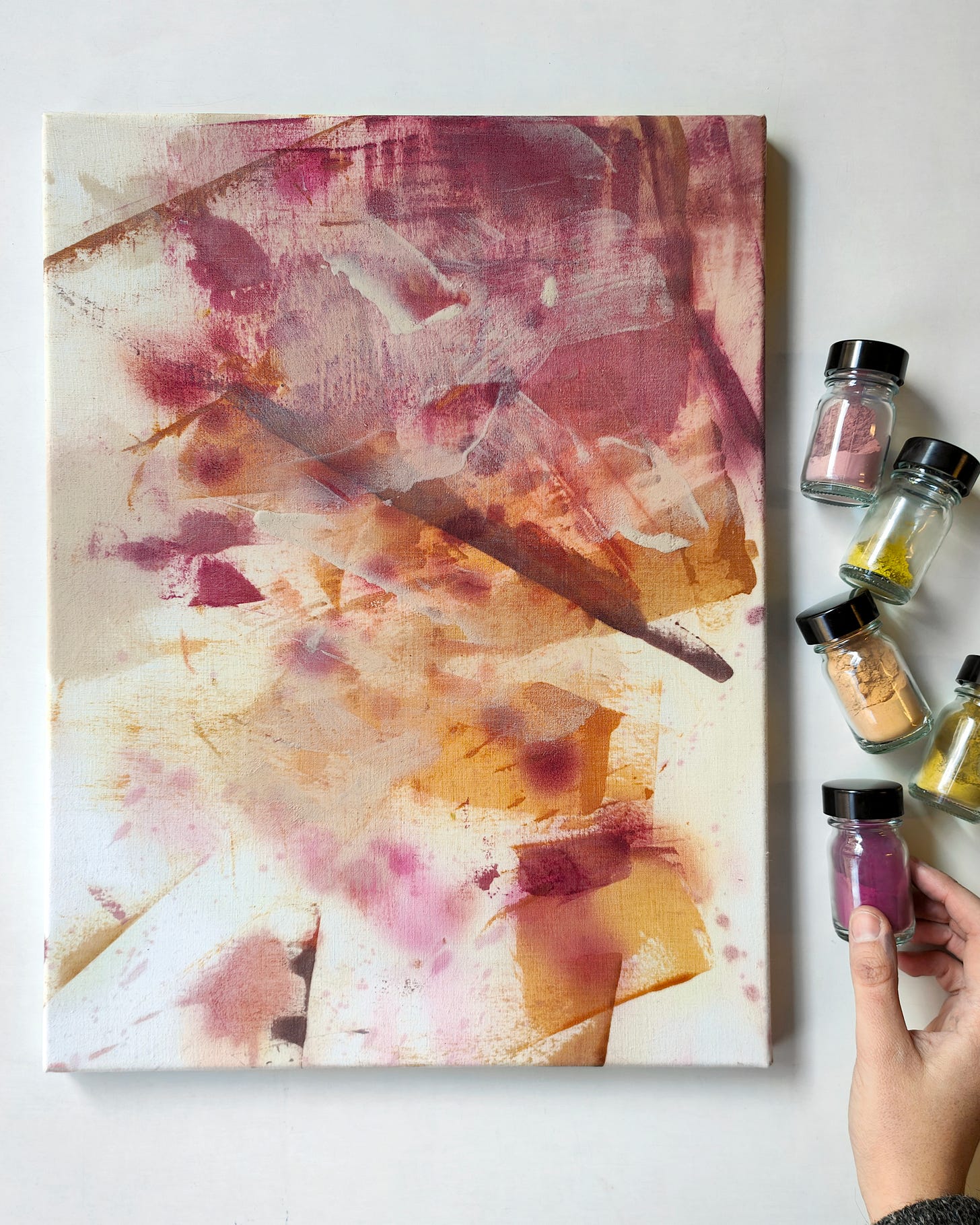
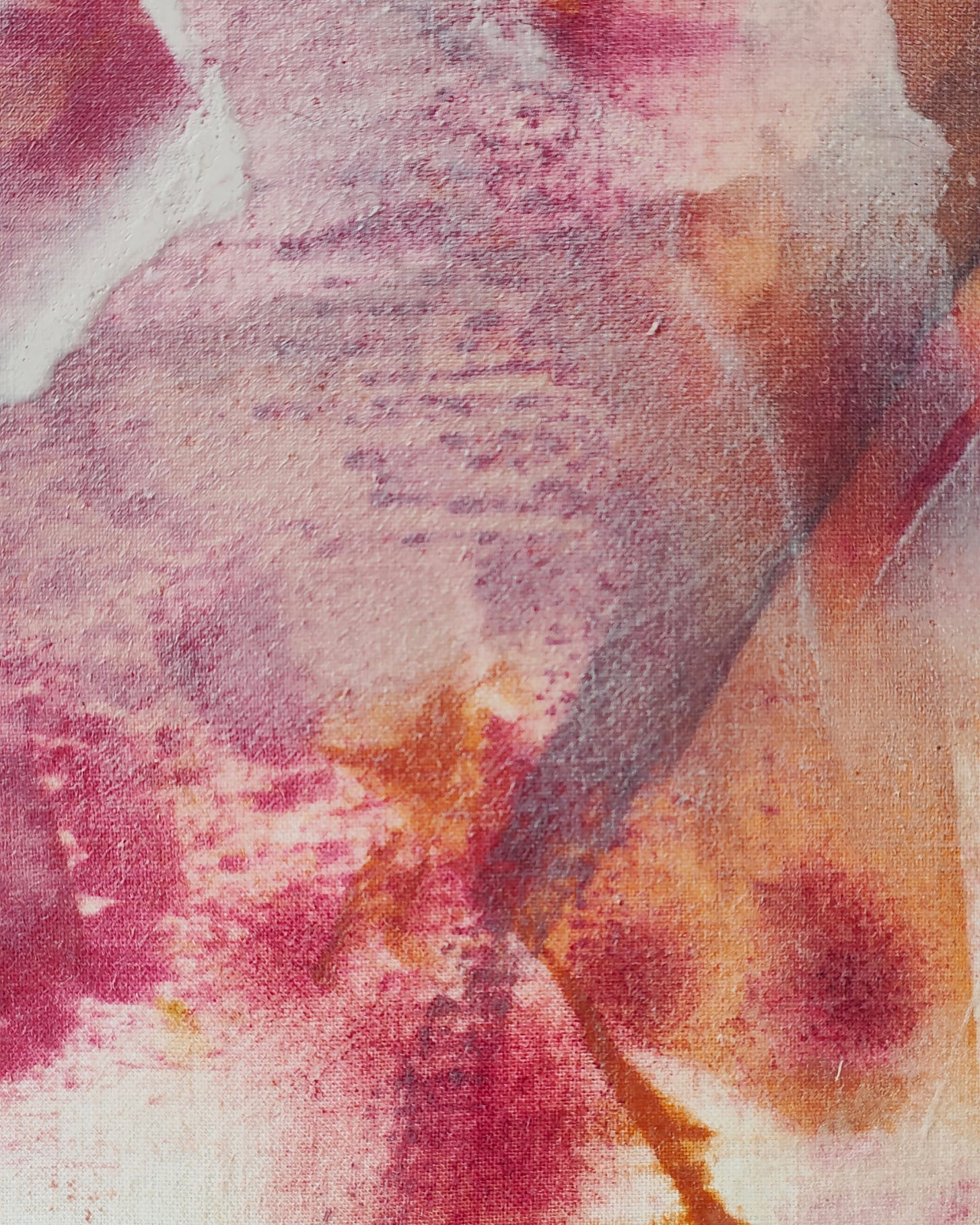
I love your perspective on this! I’ve been thinking a lot about it and trying to write my own essay about it for awhile and it hasn’t quite come together yet. One thing I love about using plant dyes is the aspect of collaboration. I can’t completely control the result I get because the plants themselves (and the soil conditions, water, weather patterns etc) also play a part in creating color. I collaborate with the plants around me to reveal that color in textiles but it’s a process that begins with the plants themselves
Such a great read, lots of interesting thoughts here! I love the analogy of natural dyes being like a wine, what a beautiful way to think of it.